8.1 - Human population dynamics
1/22
Earn XP
Name | Mastery | Learn | Test | Matching | Spaced |
|---|
No study sessions yet.
23 Terms
Crude birth rate
The number of births per thousand individuals in a population per year
Crude death rate
The number of deaths per thousand individuals in a population per year
Natural Increase Rate
The rate of human growth expressed as a percentage change per year
= (Crude birth rate - crude death rate) / 10
Doubling time
The time in years that it takes for a population to double in size
Human Development Index (HDI)
Adopted by the UN Development Programme as a measure of the “well-being” of a country. It combines the health, wealth and education into one value.
Features in MEDCs
Industrialized nations with high GDPs
Population is relatively rich
Individuals are unlikely to starve through poverty
Relatively high level of resource use per person
Relatively low population growth rates largely due to low CBR but rising CDRs
Have very high carbon and ecological footprints
Japan, North America, Europe
Features of LEDCs
Less industrialized
May have raw materials (natural capital) but this tends to be exported and processed in MEDCs
Population has a lower GDP and higher poverty rates
More people are poor with low standards of living
High population growth rates largely due to rapidly falling CDRs
Have lower carbon and ecological footprints
Demography
The study of the statistical characteristics of human populations.
Eg; total size, age and sex composition
Malthusian Theory
Believed that the human population increases geometrically whereas food supplies can grow only arithmetically. Food production can only increase to a certain level determined by the productive capacity of the land and existing levels of technology. According to this thoery, whenever population outstripped food supply ‘natural checks’ would happen. This meant population went down to a manageable level.

Limitations of Malthusian Theory
Too simplistic - ignores that it is actually only the poor who go hungry
Did not foresee food production technology advancements
Boserup’s theory
Asserted that an increase in population would stimulate technologists to increase food production. Any rise in the population will increase the demand for food and so act as an incentive to change agrarian technology and produce more food
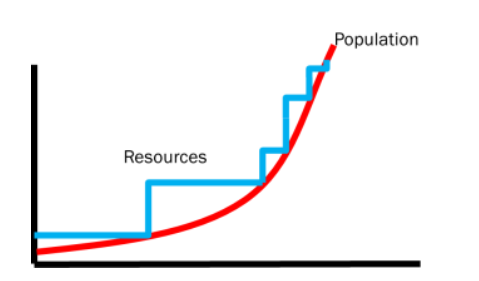
Limitations of Boserup’s theory
Is based on the assumption of a “closed” community, not reality
Overpopulation can lead to unsuitable farming practices that may degrade the land
Why do people have large families
High infant and childhood mortality
Security in old age
Children are an economic asset
Status of women
Unavailability of contraceptives
Ways to reduce family size
Provide education
Improve health
Make contraceptives available
Enhance Income
Improve resource management
Demographic transition model (DTM)
The pattern of decline in mortality and fertility of a country as a result of social and economic development. A 5-stage population model
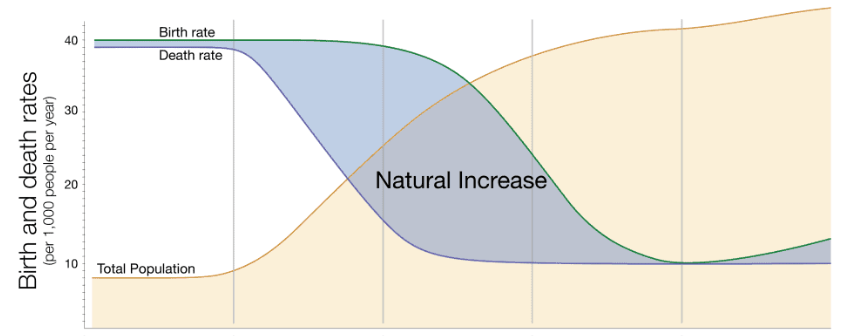
Stage 1 of the DTM
High stationary (pre-industrial societies)
High birth rate due to no birth control
High infant mortality rates
Cultural factors encouraging large families
High death rates due to disease, famine, poor hygiene, and little medicine
Birth rate: High
Death rate: High
Natural Increase: Stable or slow increase
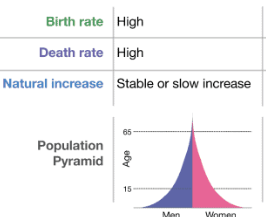
Stage 2 of the DTM
Early expanding (LEDC’s)
Death rate drops as sanitation and food improve
Disease is reduced so lifespan increases
Birth rate is still high so population expands rapidly and child mortality falls due to improved medicine
Birth rate: High
Death rate: Falls rapidly
Natural increase: Very rapid increase
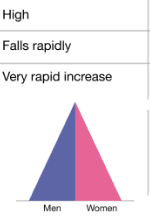
Stage 3 of the DTM
Late expanding (Wealthier LEDC’s)
Birth rates fall due to access to contraception, improved healthcare, education, emancipation of women
Population begins to level off and desire for material goods and low infant death rates mean that people have smaller families
Birth rate: Falling
Death rate: Falls more slowly
Natural Increase: Increase slows down
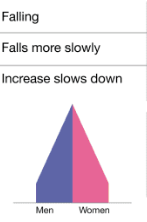
Stage 4 of the DTM
Low Stationary (MEDC’s)
Low birth and death rates
Industrialized countries
Stable population sizes
Birth rate: Low
Death rate: Low
Natural Increase: Falling then stable
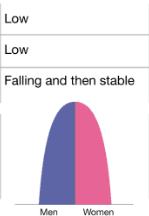
Stage 5 of the DTM
Declining (MEDCs)
Population may not be replaced as fertility rate is low
Problems of ageing workforce
Birth rate: Rising Again
Death rate: Low
Natural increase: Stable or slow increase
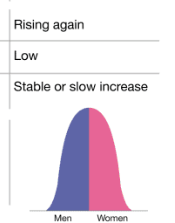
Limitations of Demographic Transition Model (DTM)
Initial model was without the fifth stage
The fall in the death rate has not always been as steep as this suggests
Does not take into account situations such as pandemics, wars, aids
Eurocentric model and assumes that all countries will become industrialized
Policies that may reduce population growth rates
Parents in subsistence (supporting themselves at minimum level) may be dependent on their children for support in their later years and this may create an incentive to heave many children
if the government introduces pension schemes, the CBR comes down
If you have to pay more tax to have more children, you may decide to have a smaller family
Policies that stimulate economic growth may reduce birth rates as a result of increased access to education about methods of birth control
Urbanization may be a factor as fewer people can live in the smaller urban accommodation
Policide directed toward the education of women and enabling women to have greater personal and economic independence may be the most effective in reducing fertility and therefore, population pressures
Policies that may increase population growth rates
Agricultural development, improved public health, sanitation, etc. may lower death rates and stimulate rapid growth without significantly affecting fertility
Lowering income tax or giving incentives and free education and health care may increase birth rates (Ex. Australia Baby Bonus)
Encouraging immigration particularly for workers (Ex. Russia allows migrants to work who do not have the qualifications to fill the gap in manual labor)